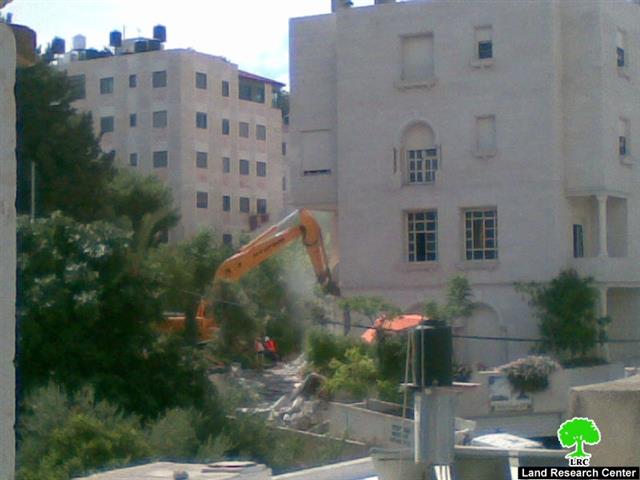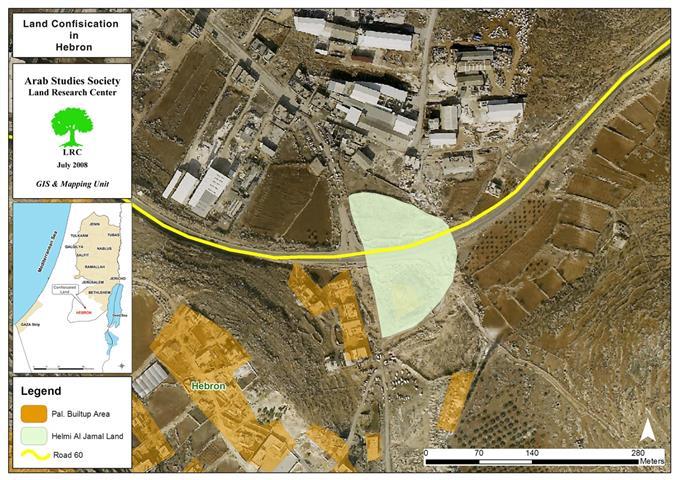Introduction:
The policy adopted by the occupation municipality of Jerusalem against Palestinian building and housing is an old-new policy that insists on demolishing and fining houses under the same pretext, building without a permit. Even if the building was 'authorized', the municipality always finds parts of it that were not authorized by its own-issued permit as to classify the building as 'illegal'. The municipality is used to deal with these 'building violations' through imposing heavy fines on the owners of such houses. Lately, however, the municipality has made its responses to the Palestinian building 'violations' more stringent as it demolishes the 'illegal' parts or forces the owner to demolish it himself. It's been the case that the removal of some of these 'violations' has caused major structural damages to the rest of the 'legalized' building especially if the violation was in the form of a second or a third floor added to the initial building.
Recently, the municipality's policy against Palestinian building in the City of Jerusalem has become harsher and much more severe than in the past as it has demolished entire buildings regardless of the number of its floors or the purpose of its establishment; for example, the municipality, assisted by the Israeli occupation forces and the Israeli Border Police, demolished on November 30th, 2005, a four-story building in Beit Hanina that was owned by the sons of Mr. Mohammad Abdel Muhsein Hasan. The insistence and resolve of the municipality to erase Palestinian buildings and housing from the city of Jerusalem was demonstrated recently in the demolishing of the 5-story building that was located near Al Dajani Hospital in Beit Hanina and belonged to Mr. Majed Abu Aisha. The building used to shelter 7 families of which 6 have bought the apartment in which they were living.
The Bulldozing of a Residential Building Sheltering More than 60 Palestinians in Beit Hanina:
Israeli occupation forces used dynamite and remote controlled ignition to bring down the Abu Eisha building in which more than 60 Palestinians used to live. The now-homeless families who used to live the building include:
-
Mr. Majed Abu Eisha, his family and his handicapped sister.
-
Mr. Khalil Ahmad Al Alami and his family.
-
Mr. Wa'el Oweida and his family.
-
Mr. Osama Oweida and his family along with his son, Ihab, and his family.
-
Mr. Jamal Kadmazi and his family.
-
Mr. Rami Zalloum and his family.
The demolition process started in the early hours of Monday June 28th, 2008 when hundreds of Israeli forces (Special Forces, Border Police, Israeli Blue Police, Intelligence, Dog Squads and bomb experts) surrounded the building at 3:00 AM. These forces raided the 7 apartments of the building while the owners and their families were sound asleep. Children, women and men were awaken by the sound of breaking doors only to find tens of heavily-armed and equipped Israeli Special Forces and their police dogs in their rooms and next to their beds. These Forces used physical violence, beating, kicking and assaulting with the butt of their rifles to move the residents out of their apartments to at least 50 meters away from the building in a state of fear, shock and total disbelief.
Almost immediately afterwards Israeli bulldozers began eating at the walls surrounding the building and the walls of the ground floor, a process that took more than 12 consecutive hours. This initial stage took a long time due to the fact that the building is surrounded by other large inhabited residential buildings. After the stage was over with, Israeli bomb experts began placing dynamite sticks and explosives in specified holes made by the bulldozers.
Photo 1: :An Israeli bulldozer demolishing the walls of the ground floor
of Majed Abu Aisha's building in Beit Hanina.
The demolishing was accompanied by a popular protest movement as hundreds of Palestinian Jerusalemites and national and religious figures were present in the vicinity of the building to protest against its demolition. However, Israeli occupation forces attacked the peaceful gathering using sticks, butts of rifles, sound bombs and teargas. The attack led to the injury of some of the participants in the gathering while others were arrested including the building's owner who stayed at the police station until after the total demolition of his estate.
Photo 2: Israeli occupation forces prevent Palestinian Jerusalemites from getting close
to Abu Aisha building while Israeli bulldozers carryout its destructive mission.
At about 5:30 PM a group of 8 municipality employees accompanied by the police, a photographer and members of the Special Forces went to nearby buildings. The purpose was to warn its residents against staying in their homes and to inform them that staying in their apartments and houses would be on their own responsibility. The entrance of each of the housing structures surrounding the Abu Aisha building was then photographed. It is worth noting here that the residents of nearby buildings (Al Qawasmeh, Abdeen, Abu Zuhriya, Karbijan buildings, among others) have officially expressed their refusal for their houses to be used as fulcrums for the destructive machines used to demolish the Abu Aisha building. They have also expressed concern that the demolition of the building will negatively affect all of the surrounding buildings.
At 6:00 PM Israeli forces removed all of the Palestinians protesting the demolition. At 6:20 PM an Israeli helicopter appeared in the sky and flew around the building a number of times before stopping southeast of it. Everybody was eyeing the helicopter before it used remote control to cause an explosion that transformed the once standing building into a pile of dust atop all of the furniture and property of its ex-residents.
Photo 3: The Israeli helicopter that destroyed the Abu Aisha building.
An eye witness gave the Land Research Center's field researcher the following testimony: ' The explosion was huge. People started shouting, crying and screaming as they called for the end of the racist occupation. They also cursed those who are advocating for the illusive and imaginary Peace. The building was turned into rubble and became yet another witness to Israel's war crimes against Palestinian humanity and property. The explosion that turned the building into scattered debris is the same explosion that turned Palestine Jerusalemites' dreams and beliefs in peace into phantoms as the right of people to housing goes beyond the actual shelter, whatever it may be. This right is about the relation between the individual and his land in the historical and demographical sense. It also means that people have the right to live in a safe and dignified environment. It is a Basic Right to which all other human rights are connected to. These human rights are the same that went into thin air when the building was destroyed.'
Photo 4: The Abu Aisha Building after it was turned into rubble atop
the furniture of the seven families who used to call the building home.
The Israeli High Court Looks into the Legality of Actions Taken by Jerusalem Municipality's General Prosecutor:
On June 13th, 2007 the Israeli High Court was discussing the legality of the actions taken by the municipality's General Prosecutor vis-� -vis the Abu Aisha building as he revoked the license granted by the municipality to Mr. Abu Aisha in 2002. Atop of the municipality license, both the local and district committees have approved the additions to the building.
Mr. Majed Abu Aisha, the owner of the building, gave the following testimony for LRC's field researcher: ' I have been following the issue of licensing the building for the past four years. Both the local and district committees have agreed to issue me the needed license especially after the fact that I have paid $250,000 in fees. I have also paid around $200,000 in legal fees for the lawyers Sami Irsheid, Ziad Qahwar, Maseed Al Hajj in addition to Youssi Arnon. The problem of the building was in its width, not its height. I was very surprised when the Lower Court issued a ruling in favor of the municipality's request to demolish the building in its entirety despite the fact that I had a building license that was issued four years ago !!!. I also managed to get the needed approval of the local committee after it issued a demolition order earlier. In turn, I submitted a legal request to the district committee to process my application as required by law. I kept on following my case with the district committee over a period of 1.5 years until I finally received its approval. I thought then that my problems are over. Yet, the municipality's General Prosecutor refused to issue me the needed permits and, instead, issued a decision to nullify and invalidate my original building permit by the end of June 2007.'
Photo 4: The building of Abu Aisha after its destruction in July 2008
Photo 5: The building of Abu Aisha after its destruction in July 2008
Photo 6: The building of Mr. Majed Abu Aisha in June2007
Prepared by:
The Land Research Center
LRC



















